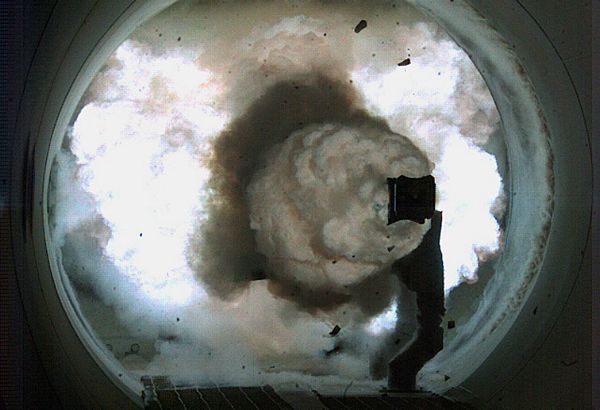The result: a weapon that can hit a target 100 miles or more away within minutes, seven times as far as current ship-mounted guns.
The Office of Naval Research (ONR) achieved a milestone yesterday when it successfully conducted a world-record 33-megajoule shot of the Electromagnetic Railgun aboard Naval Surface Warfare Center Dahlgren Division. A megajoule is a measurement of energy associated with a mass traveling at a certain velocity. In simple terms, a one-ton vehicle moving at 100 mph equals a megajoule of energy.

High-speed camera image of the Office of Naval Research Electromagnetic Railgun located at the Naval Surface Warfare Center Dahlgren Division, firing a world-record setting 33 mega-joule shot, breaking the previous record established Jan. 31, 2008. The railgun is a long-range, high-energy gun launch system that uses electricity rather than gunpowder or rocket motors to launch projectiles capable of striking a target at a range of more than 200 nautical miles with Mach 7 velocity. A future tactical railgun will hit targets at ranges almost 20 times farther than conventional surface ship combat systems. (U.S. Navy photo/Released)
"Today's railgun test demonstrates the tactical relevance of this technology, which could one day complement traditional surface ship combat systems," said Rear Adm. Nevin Carr, chief of naval research.
"The 33-megajoule shot means the Navy can fire projectiles at least 110 nautical miles, placing Sailors and Marines at a safe standoff distance and out of harm's way, and the high velocities achievable are tactically relevant for air and missile defense," he said. "This demonstration moves us one day closer to getting this advanced capability to sea."
Besides the extended ranges, the railgun also improves safety for Sailors and Marines because it will eliminate the need for a high-energy explosive warhead and traditional gun propellants. Removing explosives and chemicals will also reduce the munitions logistic chain.
In 2008, ONR conducted a 10-megajoule railgun shot for media and visitors at Dahlgren. Today's demonstration showed researchers are steadily progressing toward developing a railgun that could hit targets almost 20 times farther than conventional ship combat systems. A 33-megajoule shot, for example, could potentially reach extended ranges with Mach 5 velocity, five times the speed of sound.
So when will it be ready? The Navy says they want their railguns to fire 6-12 rounds a minute and they would have those fully-functional railguns on the decks of U.S. Navy ships in the 2025 time frame. With GPS that would mean pinpoint accuracy as far as 200 miles away.
Future warfare isn't here just yet but this test is 3X better than the one in 2008 - so it's getting closer.






Comments